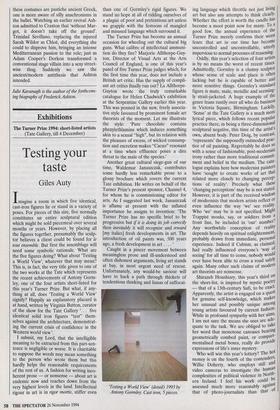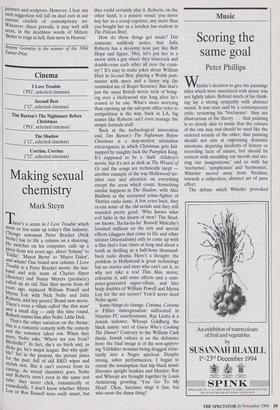Exhibitions
The Turner Prize 1994: short-listed artists (Tate Gallery, till 4 December)
Testing your taste
Giles Auty
Imagine a room in which five identical, cast-iron figures lie or stand in a variety of poses. For pieces of this size, five normally constitutes an entire sculptural edition which might be sold piecemeal over several months or years. However, by placing all the figures together, presumably the sculp- tor believes a client could be found for le tout ensemble. But first the assemblage will need some symbolic rationale. What are the five figures doing? What about 'Testing a World View', whatever that may mean? This is, in fact, the very title given to one of the two works at the Tate which represents the recent achievements of Antony Gorm- ley, one of the four artists short-listed for this year's Turner Prize. But what, if any- thing at all, does 'Testing a World View' signify? Happily an explanatory placard is at hand, written by Virginia Button, curator of the show for the Tate Gallery '... five identical solid iron figures "test" them- selves against the architecture, demonstrat- ing the current crisis of confidence in the Western world view'.
I submit, my Lord, that the intelligible meaning to be extracted from this part-sen- tence is negligible or worse. It is charitable to suppose the words may mean something to the person who wrote them but this hardly helps the reasonable requirements of the rest of us. A fashion for writing inco- herent prose — or nonsense — about art is endemic now and reaches down from the very highest levels in the land. Intellectual rigour in art is in rigor mortis, stiffer even than one of Gormley's rigid figures. We stand no hope at all of ridding ourselves of a plague of poor and pretentious art unless we grapple with the festoons of mangled and misused language which surround it.
The Turner Prize has become an annual occasion for wheeling out the cultural big guns. What calibre of intellectual ammuni- tion do they fire? Marjorie Allthorpe-Guy- ton, Director of Visual Arts at the Arts Council of England, is one of this year's panel of five Turner Prize judges which, for the first time this year, does not include a British art critic. Has the supply of compli- ant art critics finally run out? La Allthorpe- Guyton wrote the truly remarkable catalogue for Helen Chadwick's exhibition at the Serpentine Gallery earlier this year. This was penned in the new, freely associa- tive style favoured by prominent female art theorists of the moment. Let me illustrate the style: 'Pure chocolate contains phenylethlamine which induces something akin to a sexual "high", but its relation with the pleasure of excess, of wicked consump- tion and excretion makes "Cacao" resonant at a time when effluence poses a dire threat to the male of the species.'
Another great cultural siege-gun of our time, Waldemar Januszczak, contributes some hardly less remarkable prose to a glossy brochure which covers the current Tate exhibition. He writes on behalf of the Turner Prize's present sponsor, Channel 4, for whom he is commissioning editor for arts. As I suggested last week, Januszczak is aflame at present with the inflated importance he assigns to invention: 'The Turner Prize has no specific brief to be progressive but if it is doing its job correctly then inevitably it will recognise and reward [my italics] fresh developments in art. The introduction of oil paints was, 500 years ago, a fresh development in art .... '
Caught in a pincer movement between meaningless prose and ill-understood and often dishonest arguments, living art stands at bay, in most urgent need of rescue. Unfortunately, any would-be saviour will have to hack a path through thickets of tendentious thinking and lianas of suffocat- Testing a World Flew' (detail) 1993 by Antony Gormley. Cast iron, 5 pieces. ing language which throttle not just living art but also any attempts to think clearly. Whether the effort is worth the candle has become a moot point now for many. To a good few, the annual experience of the Turner Prize merely confirms their worst fears: that art in our time has become uncontrolled and uncontrollable, utterly impervious to normal processes of reasoning. Oddly, this year's selection of four artists is by no means the worst of recent times. Admittedly, Gormley is a clumsy sculptor whose sense of scale and place is often lacking but he is capable of better and more sensitive things. Gormley's standard figure is mute, male, metallic and seeming- ly strait-jacketed. A huge example of the genre leans rustily over all who do business in Victoria Square, Birmingham. Luckily, `Sense' at the Tate Gallery is a much more lyrical piece, which follows recent popular practice there, in being a three-dimensional sculptural negative, this time of the artist's own, absent body. Peter Doig, by contrast, `represents' the supposedly outmoded prac- tice of oil painting. Regrettably he does so with a sense of fashionable, post-modernist irony rather than more traditional commit- ment and belief in the medium. The cata- logue explains here how modernist painters have 'sought to create works of art that related more closely to changing percep- tions of reality'. Precisely what these `changing perceptions' may be is not stated. However, it is part of the received wisdom of modernists that modern artists reflect or even influence the way 'we' see realitY. Who 'we' may be is not specified. Might Trappist monks, say, or soldiers from front line, be included in 'our' number? Any worthwhile conception of reality depends heavily on spiritual enlightenment, probably drawn from immediate, personal experience. Indeed if Cubism, as claimed, had really influenced everyone's 'way of seeing' for all time to come, nobody would ever have been able to cross a road safelY again. Many other such claims of modern art theorists are nonsense.
Shirazeh Houshiary, this year's third 00 the short-list, is inspired by mystic poetry that of a 13th-century Sufi, to be exact. Apparently, the artist is engaged on a quest for genuine self-knowledge, which makes her unusual and possibly unique among young artists favoured by current fashion. While in profound sympathy with her auns, I am not sure the means she uses are ade- quate to the task. We are obliged to take her word that monotone canvases bearing geometrically combed paint, or compart- mentalised metal boxes, really do provide expressions of life's inner mystery. Who will win this year's lottery? The hot money is on the fourth of the contenders, Willie Doherty, who employs still and video cameras to investigate the human complexities of political violence in North- ern Ireland. I feel his work could he assessed much more reasonably against, that of photo-journalists than that 01 painters and sculptors. However, I fear any such suggestion will fall on deaf ears in our Current citadels of contemporary art. Wherever chaos prevails, it may well still seem, in the deathless words of Milton: Better to reign in hell, than serve in Heaven.'
Antony Gormley is the winner of the 1994 Turner Prize.











































































 Previous page
Previous page